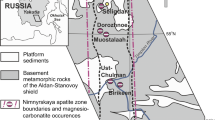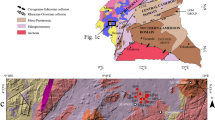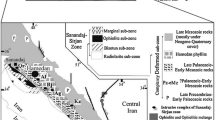Abstract
The Kovdor baddeleyite–apatite–magnetite deposit in the Kovdor phoscorite–carbonatite pipe is situated in the western part of the zoned alkali-ultrabasic Kovdor intrusion (NW part of the Fennoscandinavian shield; Murmansk Region, Russia). We describe major intrusive and metasomatic rocks of the pipe and its surroundings using a new classification of phoscorite–carbonatite series rocks, consistent with the IUGS recommendation. The gradual zonation of the pipe corresponds to the sequence of mineral crystallization (forsterite–hydroxylapatite–magnetite–calcite). Crystal morphology, grain size, characteristic inclusions, and composition of the rock-forming and accessory minerals display the same spatial zonation pattern, as do the three minerals of economic interest, i.e. magnetite, hydroxylapatite, and baddeleyite. The content of Sr, rare earth elements (REEs), and Ba in hydroxylapatite tends to increase gradually at the expense of Si, Fe, and Mg from early apatite–forsterite phoscorite (margins of the pipe) through carbonate-free, magnetite-rich phoscorite to carbonate-rich phoscorite and phoscorite-related carbonatite (inner part). Magnetite displays a trend of increasing V and Ca and decreasing Ti, Mn, Si, Cr, Sc, and Zn from the margins to the central part of the pipe; its grain size initially increases from the wall rocks to the inner part and then decreases towards the central part; characteristic inclusions in magnetite are geikielite within the marginal zone of the phoscorite–carbonatite pipe, spinel within the intermediate zone, and ilmenite within the inner zone. The zoning pattern seems to have formed due to both cooling and rapid degassing (pressure drop) of a fluid-rich magmatic column and subsequent pneumatolytic and hydrothermal processes.














Similar content being viewed by others
References
Afanasyev AP, Sulimov BI, Ternovoy VI (1970) A formation of the Kovdor massif of ultrabasic alkaline rocks. Izv Vuzov Geol Explor 11:83–89 (in Russian)
Amelin Y, Zaitsev AN (2002) Precise geochronology of phoscorites and carbonatites: the critical role of U-series disequilibrium in age interpretations. Geochim Cosmochim Acta 66:2399–2419. doi:10.1016/S0016-7037(02)00831-1
Bayanova TB, Kirnarsky YM, Levkovich NV (1997) U-Pb study of baddeleyite from Kovdor massif rocks. Dokl Akad Nauk 356:509–511 (in Russian)
Chvikov AN, Sinkov PS, Rupyshev MS, Pospelov AN, Shchelchkova AV (2010) Block modeling the Kovdor deposit. Unpublished report. RJC Group, Saint-Petersburg
Eurochem (2014) Annual Report and Accounts 2013
Gittins J (1989) The origin and evolution of carbonatite magmas. In: Bell K (ed) Carbonatites: genesis and evolution. Unwin Hyman, London, pp 580–600
Guidelines on Alignment of Russian minerals reporting standards and the CRIRSCO Template (2010) GKZ – CRIRSCO, Moscow
Hay RL (1983) Natrocarbonatite tephra of Kerimasi volcano, Tanzania. Geology 11:599–602. doi:10.1130/0091-7613(1983)11<599:NTOKVT>2.0.CO;2
Ivanyuk GYu, Yakovenchuk VN, Pakhomovsky YaA (2002) Kovdor. Laplandia Minerals, Apatity
Kapustin YL (1980) Mineralogy of carbonatites. Amerind Publishing, New Delhi
Kapustin YL (1983) Explosion pipes in carbonatite complexes. Soviet Geol 4:102–114 (in Russian)
Khramov DG (ed.) (2014) On condition and use of mineral resources of the Russian Federation in 2012. State report. Mineral, Moscow. http://www.mnr.gov.ru/regulatory/list.php?part=1564. Accessed 25 Feb 2015 (in Russian)
Krasnova NI (2001) The Kovdor phlogopite deposit, Kola Peninsula, Russia. Can Mineral 39:33–44. doi:10.2113/gscanmin.39.1.33
Krasnova NI, Kopylova LN (1988) Geological basis for mineral-technological mapping at the Kovdor ore deposit. Int Geol Rev 30:307–319. doi:10.1080/00206818809466011
Krasnova NI, Balaganskaya EG, Garcia В (2004) Kovdor—classic phoscorites and carbonatites. In: Wall F, Zaitsev AN (eds) Phoscorites and carbonatites from mantle to mine: the key example of the Kola alkaline province, vol 10, Mineralogical Society Series. Mineralogical Society, London, pp 99–132
Krivovichev SV, Yakovenchuk VN, Zhitova ES, Zolotarev AA, Pakhomovsky YA, Ivanyuk GY (2010a) Crystal chemistry of natural layered double hydroxides. 1. Quintinite-2H-3c from Kovdor alkaline massif, Kola peninsula, Russia. Mineral Mag 74:821–832. doi:10.1180/minmag.2010.074.5.821
Krivovichev SV, Yakovenchuk VN, Zhitova ES, Zolotarev AA, Pakhomovsky YA, Ivanyuk GY (2010b) Crystal chemistry of natural layered double hydroxides. 2. Quintinite-1M: first evidence of monoclinic polytype in M 2+-M 3+ layered double hydroxides. Mineral Mag 74:833–840. doi:10.1180/minmag.2010.074.5.833
Kukharenko AA, Orlova MP, Bulakh AG, Bagdasarov EA, Rimskaya-Korsakova OM, Nefedov EI, Il’inskiy GA, Sergeev AS, Abakumova NB (1965) The Caledonian complex of the ultrabasic, alkaline rocks and carbonatites of the Kola Peninsula and Northern Karelia (geology, petrology, mineralogy and geochemistry). Nedra, Moscow (in Russian)
Le Maitre RW (ed) (2002) Igneous rocks. A classification and glossary of terms. Recommendations of the International Union of Geological Sciences Subcommission on the Systematics of Igneous Rocks. Cambridge University Press
Letnikov FA (1990) Synergetics of geological systems. Nauka, Novosibirsk (in Russian)
Mikhailova YA, Krasnova NI, Kretser YL, Wall F, Pakhomovsky YA (2002) Inclusions in minerals of the Kovdor intrusion of ultrabasic, alkaline rocks and carbonatites as indicators of the endogenic evolution processes. In: Vladykin NV (ed) Deep-seated magmatism, magmatic sources and the problem of plumes. Siberian Branch of RAS, Irkutsk–Vladivostok, pp 296–320 (in Russian)
Rimskaya-Korsakova, OM, Krasnova NI (2002) Geology of the deposits of Kovdor massif. St. Petersburg University Press (in Russian)
Rodionov NV, Belyatsky BV, Antonov AV, Kapitonov IN, Sergeev SA (2012) Comparative in-situ U–Th–Pb geochronology and trace element composition of baddeleyite and low-U zircon from carbonatites of the Palaeozoic Kovdor alkaline–ultramafic complex, Kola Peninsula, Russia. Gondwana Res 21:728–744. doi:10.1016/j.gr.2011.10.005
Shats LA, Sorokina II, Kalinkin MM, Kornyushin AM (1967) Report about geophysical works, made by the Kovdor geological party in an area of Kovdor in 1966. Archives of the Natural Reserves Department of the Murmansk region, Apatity (in Russian)
Streckeisen A (1980) Classification and nomenclature of volcanic rocks, lamprophyres, carbonatites and melilitic rocks, IUGS Subcommission on the Systematics of Igneous Rocks, recommendations and suggestions. Geol Rundsch 69:194–207. doi:10.1007/BF01869032
Ternovoy VI (1977) Carbonatite massifs and their ores. Leningrad State University publishing (in Russian)
Wall F, Zaitsev AN (eds) (2004) Phoscorites and carbonatites from mantle to mine: the key example of the Kola alkaline province, vol 10, Mineralogical Society Series. Mineralogical Society, London
Yegorov LS (1993) Phoscorites of the Maymecha-Kotuy ijolite-carbonatite association. Int Geol Rev 35:346–358. doi:10.1080/00206819309465533
Zaitsev AN, Keller J (2006) Mineralogical and chemical transformation of Oldoinyo Lengai natrocarbonatites, Tanzania. Lithos 91:191–207. doi:10.1016/j.lithos.2006.03.018
Zaitsev AN, Wenzel T, Vennemann T, Markl G (2013) Tinderet volcano, Kenya: an altered natrocarbonatite locality? Mineral Mag 77:213–226. doi:10.1180/minmag.2013.077.3.01
Zhitova ES, Yakovenchuk VN, Krivovichev SV, Zolotarev AA, Pakhomovsky YA, Ivanyuk GY (2010) Crystal chemistry of natural layered double hydroxides. 3. The crystal structure of Mg, Al-disordered quintinite-2H. Mineral Mag 74:841–848. doi:10.1180/minmag.2010.074.5.841
Acknowledgments
We are grateful to Dr. N.I. Krasnova and Prof. Bernd Lehmann for comments and corrections improving the manuscript. The research has been carried out in the framework of supplementary exploration of deep horizons of the Kovdor deposit, developed by JSC Kovdorskiy GOK during 2007 to 2011. It was also supported by the Presidium of the Russian Academy of Sciences (project 1.2.4 of Program No. 27), the Russian Foundation for Basic Research and the Murmansk Region Government (grant 12-05-98802), and Laplandia Minerals Ltd. (Apatity, Russia).
Author information
Authors and Affiliations
Corresponding author
Additional information
Editorial handling: B. Lehmann
Rights and permissions
About this article
Cite this article
Mikhailova, J.A., Kalashnikov, A.O., Sokharev, V.A. et al. 3D mineralogical mapping of the Kovdor phoscorite–carbonatite complex (Russia). Miner Deposita 51, 131–149 (2016). https://doi.org/10.1007/s00126-015-0594-z
Received:
Accepted:
Published:
Issue Date:
DOI: https://doi.org/10.1007/s00126-015-0594-z




